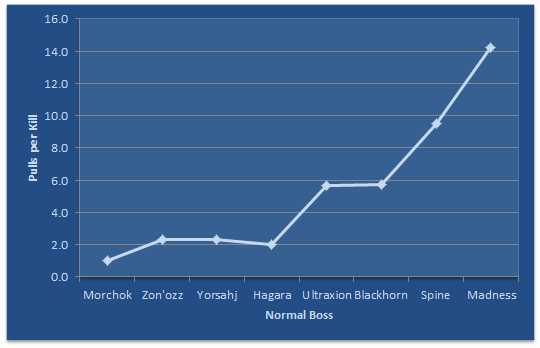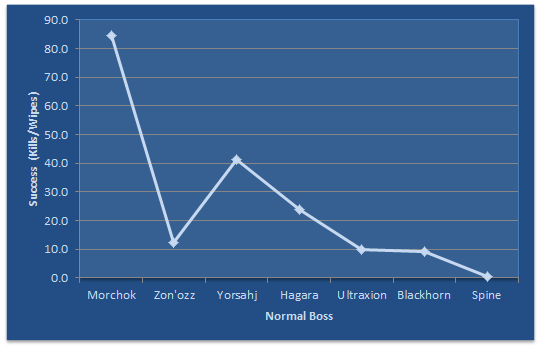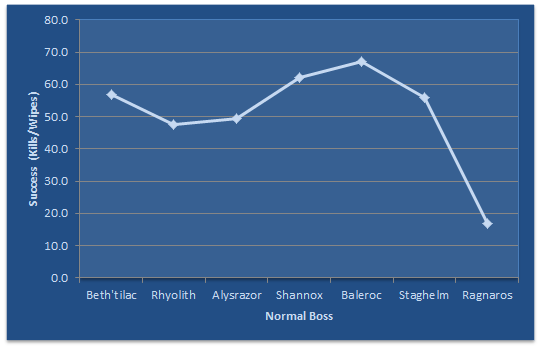
A hot topic lately is the level of challenge in the game. In this post I will look at the factors that add challenge to healing, and ask if healing is challenging enough, and where the future lies for stretching healers as Cataclysm information trickles out.
Game Mechanics
The designers of classes and encounters have several different aspects of healing to work with to set the difficulty. Those this post will deal with specifically are: spell availability, reaction time, the need for triage, mana management and coordination.
Spell Availability
Consider a “standard” 25-man healing team of 6 people. You might aim to include one or two paladins, a disc priest and then at least one each of the other specs, ideally no more than two of each. This allows you to have a baseline level of cover for sustained tank damage, increase the general raid survivability, and then have a full range of spells to use against the various extra types of damage thrown out in the encounter, from raid-wide auras to targeted flame patches and everything in between.
Depending on your guild you may or may not choose adapt the healing team to the encounter; it seems sensible if you’re interested in min/maxing, although these days for most raid groups this isn’t necessary as long as your composition isn’t too pathological. I have happy memories of 2-healing Ulduar as a Disc Priest alongside a Holy Paladin, and adapting just fine.
Blizzard’s stated design is for most encounters to be accessible for a most healing teams, and they succeed to a large extent, but in my experience this is one thing that can dramatically increase the relative difficulty of 10-man compared to 25-man raiding. In the previously-mentioned Disc + Holy Paladin example we lacked the tools to handle raid-wide damage fights effectively, Kologarn being a good example. We managed, but a Holy Priest or Resto Druid would have laughed that off.
In a 5-man this problem is even more acute since the only spells available are those you bring with you. The contrast between Forgemaster Garfrost as a Holy Paladin and as a Resto Druid is quite simply day and night. The contrast of course reverses once the group moves beyond Ick and suddenly the tank is taking insane damage and I wish I had my spammable Holy Light back.
Has this philosophy of allowing a broader range of compositions to succeed detracted from the difficulty? I’d argue that it probably has not. What has changed is that the more extreme damage profiles which strongly favoured stacking one class or another have gone away, and classes have been strategically nerfed to remove over-reliance on single spells (CoH being the prime example).
I would not like to see a total removal of unusual damage profiles, because drawing healers outside their comfort zones is a huge positive. However the playerbase tends to react to this by insisting that Blizzard has “forced” some sort of odd composition upon them. This can be avoided to an extent by varying the healing requirements throughout the fight, much as Festergut does well in Icecrown.
Reaction Time
Unlike the spells, which are largely fixed as a function of the healers you have available, reaction time is a property of the individual healer. Healers are often called upon to respond to things like spike damage debuffs (Frost Blast, Penetrating Cold), Tank killers requiring cooldowns (Plasma Blast, Flame Breath), or to cover for each other (healers being taken by a Val’kyr, or just about anything on Sindragosa). Reaction time demands can be adjusted by designers to increase the difficulty of an encounter.
The reaction time of a given healer depends on a number of factors. First there’s their client-server latency; then once their client has the information there’s another delay while their UI digests that information and presents it to them; next comes the human response time while they notice the event, decide on an action and execute it; finally there is a second client-server latency while the server notices the action the player chose to take.
Having played on the Oceanic servers I can understand the impact of latency. My guild at the time was working through Karazhan but simply could not defeat Maiden because both of our main healers were running with ~1k ping and could not react to the Holy Fire in time.
As a raid leader or healing lead it is crucial to understand the reaction times of your healers when assigning them roles. Tank healers can often get away with worse latency than raid healers since the rotation and reactions are less demanding, although the players at the top of your external cooldown rotation should be those with quicker reactions.
My view is that this can be a great way to stretch your healers, as long as it is used relatively sparingly. I enjoy being called on to pay attention and it is a good way to distinguish myself as someone with
higher awareness. However obviously the game designers need to allow for a wide range of connections and not unduly penalise those with fairly high latency.
Triage and Throughput
Triage is the art of prioritising limited resources according to greatest need. This becomes relevant when throughput is inadequate to cover everyone, and there is a need for quick decision-making, as opposed to just quickly executing a pre-defined action.
Triage is definitely more of an art than a science: in practice the best triage healers draw on their experience of the damage profile of the fight, the individuals taking damage, and the habits of their fellow healers when making their decisions, reacting almost instinctively.
In Wrath triage has fallen by the wayside in many cases, a fact which has been acknowledged recently by Ghostcrawler when commenting that generally people are not left at low health for extended periods of time. This is as a result of large hits and large heals becoming commonplace, creating a situation where allowing people to be left to be healed to full over the duration of a mana-efficient HoT is a dangerous business.
Generally Wrath felt like it scaled too far: healing output and tank avoidance/mitigation scaled overly high, so boss damage was scaled to compensate, to the point where everyone ended up in real danger of being 2-shotted. I expect lessons have been learned though.
I’m extremely excited by the proposed changes for Cataclysm which will alter the ratio of heals to health pools. When the throughput the healing team is capable of doesn’t overwhelm the incoming damage by so much, the question of where that scarce healing is spent becomes much more important. Currently a 25-man Decimate can be recovered from fully in a couple of seconds with AoE heals, rather than having to prioritise the lowest members until you can get around to the rest. Contrast this to Naj’entus in the Black Temple, where it was a huge challenge to keep as many people as possible above 50% before the next bubble needed to be burst.
I’m looking forward to more orange health bars in Cataclysm. This is a valuable tool to increase the challenge of healing which should get more use.
Mana
In conjunction with the throughput-mandated triage described above, there is also mana-mandated triage: can you afford to use that AoE heal or should you heal only those people under 50%? Can they survive long enough for a HoT to be used instead?
When working through the more difficult heroics in my quest blues back in November 2008 I had significant mana issues. I just couldn’t heal the way I had been healing in TBC, so I had to be very careful with who and how I healed. Sometime during the Tier 7 content, and certainly by the time I was raiding Ulduar, I had all but lost the ability to go OOM unless I really worked at it. Clearly it is still possible to burn through an entire mana pool, but under normal conditions there is no compelling reason not to always be casting and to select efficiency over throughput.
Throughput requirements are inextricably linked to mana management: if healers go through phases with lower damage then efficient but slower heals regain their value, while in high-damage scenarios the pressure to use the quick, expensive heals overrides other concerns.
And when throughput or mana are at a premium there is also pressure to reduce overhealing to a bare minimum, another test of healer skill and coordination.
The trouble is that mana management is a difficult balance for class and encounter designers. Spell costs remain fixed over time, while regeneration from gear can more than double as an expansion progresses. Retaining the ability to run out of mana in Icecrown while not making Naxx unmanageable would be all but impossible without also changing the character of healing as the expansion progresses as well, requiring the more mana-profligate style that the acquired gear allows.
The challenge for the designers of future raids and for the class designers come Cataclysm then is to rein in mana regeneration or increase spell costs, and to better differentiate the efficient heals from the inefficient so there is a real choice to be made.
A lot has been posted on forums and blogs about whether mana management is “fun” or not. Personally I would state categorically that yes, it is fun. A mechanic which presents you with a decision to make adds to the interest of playing a healer. These sorts of decisions test your ability to appraise the global situation and predict how that will change, as opposed to the reaction-based mechanics that dominate current raiding.
After all, if you prefer to cast a standard rotation or spell for 5-10 minutes without regard to your blue bar, you’re essentially just DPSing in the opposite direction, without the interactions, procs and target switches which make DPS interesting.
Coordination
Much has been written about the healer rotations in Vanilla, where one group of healers would heal until they ran low on mana, at which point a second group would take over while the former stood around regenerating mana. Few people would argue for a return to this situation, but designing encounters with more coordination in mind would be a good way of challenging healing teams.
How many times have you joined a PuG and been given little or no direction about healing assignments, only to see tanks fall over shortly afterwards? The trouble is, more often than not this actually tends to Just Work. Paladins will gravitate towards tanks, Resto Druids will tend to rejuv-blanket (if it’s appropriate), Resto Shaman will throw Chain Heals left, right and centre and so on.
A good example of a fight where coordination is more valuable is Sindragosa, especially in Phase 3. You will likely have 3 healers out of action at any one time, possibly more if the healers with Unchained Magic are also losing their stacks at the time. Awareness and coordination are vital for this to provide cover for the roles which are unavailable.
Another great example is Anub’Arak, where assigning healers to Penetrating Cold targets is vital, and cover needs to be assigned in case that assignment will not be covered due to death, lack of mana or any other reason.
Where coordination feels required in Wrath is where either a number of healers are removed from the equation, or where the damage profile is unusual enough that “standard” healing practices simply won’t cover it. I hope to see more of both types of encounters in the future, but there needs to be a way to reintroduce more coordination across the board.
Perhaps including larger spaces in which to fight could be another mechanism for coordinating healers, since it is much more difficult to cross-heal when sections of the raid are out of range. Recent painful experiences with Infest + Defile combinations on the Lich King have inspired this thought.
My suspicion is that restricting throughput availability alone, either through constrained mana or low output to damage ratios, will drive us further in the direction of reducing overhealing and getting healing efficiently to where it’s needed, which will in turn raise the level of coordination that feels natural in raids. But of course this remains to be seen.
Conclusions
On the whole I feel that healing in Wrath is still challenging, but isn’t as cerebral as it once was and could be again. Healing is less about decision-making, spell-selection and intelligent cross-healing and far more about maximising throughput on a general assignment. My admittedly rose-tinted memories of TBC have “spam-healing” as a rare exception rather than the rule. Triage has been marginalised in favour of “blanketing”.
For Cataclysm I would be happy to see a return to a slightly slower-paced approach to healing where using the right spell at the right time is the peak of performance, and strong teamwork trumps sniping and heal-stomping.
The lessons learned from Wrath should prevent the kind of massive surplus of throughput and regeneration we’re currently seeing in Icecrown from requiring such large amounts of boss damage, and the proposed change to health pools and mana costs should push healers back towards efficiency again.
Possibly Related Posts:









